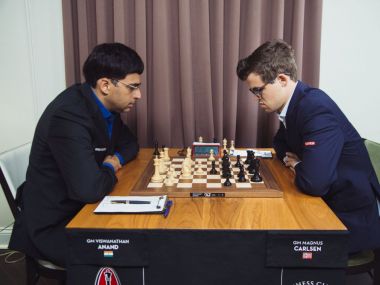Viswanathan Anand faced a tough challenge when he made a simple oversight and lost a pawn on the 40th move, but still defended precisely to force a draw in a rook endgame after a five-and-a-half-hour defence against reigning World Champion and long-time rival, Magnus Carlsen. Though all the games ended in a draw, it was a day of tough defences all around, almost all of them well-fought. For Anand, his much-awaited clash against Carlsen went sedately, as he surprisingly faced the Graz Variation of the Ruy Lopez Opening, which Carlsen has employed only rarely in the past. Anand is a connoisseur of the variation and has always played the sharpest continuations starting with 7.a4 in this particular position. [caption id=“attachment_3897767” align=“alignleft” width=“380”] Viswanathan Anand had to dig hard and defend doggedly against Magnus Carlsen. Image courtesy: Lennart Ootes[/caption] But after thinking for a few minutes and acting practically, he chose the sedate 7.Nc3 thus avoiding sharp lines and refusing to be drawn into a theoretical battle against an assumingly well-prepared opponent. This may be a good psychological ploy decided at the spur of the moment, but the downside being the game going into well-known structures of a quiet Ruy Lopez. As a result, Carlsen had achieved a satisfactory equality by the 17th move. Having played each other a whopping 57 times in classical form of chess including two World Championship matches — not counting the rapid and blitz encounters — it is not a secret that both the adversaries know each other thoroughly. So, when Carlsen started regrouping his pieces by the 20th move, there was no doubt that Anand was looking at a long and precise defence and the psychological edge had passed over to Carlsen. Fancying Carlsen’s chances in his favourite type of position, Russian Grandmaster Teimour Radjabov even tweeted:
Anand may lose this. #SinquefieldCup
— Teimour Radjabov (@rajachess) August 4, 2017
However, Anand decided to dig deep and started defending precisely. By the 27th move, the game further simplified into an ending with two rooks and a bishop each, but Carlsen’s manoeuvres became more subtle in what is possibly his biggest strength in chess — patiently targeting opponent’s weaknesses and bringing about a stage where he is forced to defend long without much margin of error. As the game approached the time control, Anand missed a better defence on the 38th move and blundered a pawn on the 40th move, landing himself into difficulties. However, pulling himself together and putting up his most stoic foot forward, he defended stubbornly to steer the game into a rook ending where he was down a pawn but the game being theoretically drawn. The game ended on the 66th move. Maxime Vachier-Lagrave and Peter Svidler played the most tactical encounter of the day where Svidler was forced to give up a pawn on the 21st move to strive for complications. Though the resultant major pieces endgame looked better for Vachier-Lagrave, Svidler’s resourceful defence crowned by the shot 32…d5! allowed him to escape with a draw. Even losing the first two games in roller-coaster games, Russian Ian Nepomniachtchi found enough courage to play a bold and wild game from the black side of a Closed Sicilian game against American Fabiano Caruana. Though Caruana seemed to have his chances, Nepomniachtchi’s ingenuity to create complications was rewarded with a draw by the 38th move. The all-American clash between Wesley So and Hikaru Nakamura had the latter forced to defend a pawn down ending for a long time, though ending in a draw ultimately after 69 moves. Probably disheartened by tough losses in the previous round, Karjakin and Aronian drew their game in just 23 moves. Results (3rd Round): Viswanathan Anand (1) ½ - ½ Magnus Carlsen (1½) Maxime Vachier-Lagrave (1½) ½ - ½ Peter Svidler (½) Fabiano Caruana (1½) ½ - ½ Ian Nepomniachtchi (0) Wesley So (1) ½ - ½ Hikaru Nakamura (1) Sergey Karjakin (1) ½ - ½ Levon Aronian (1) Points position after 2 rounds: 1: Carlsen, Caruana & Vachier-Lagrave:2 points each 4: Anand, So, Aronian, Karjakin & Nakamura: 1½ each 9: Svidler: 1 10: Nepomniachtchi: ½ V Saravanan is an International Master and author for ChessBase India


)




